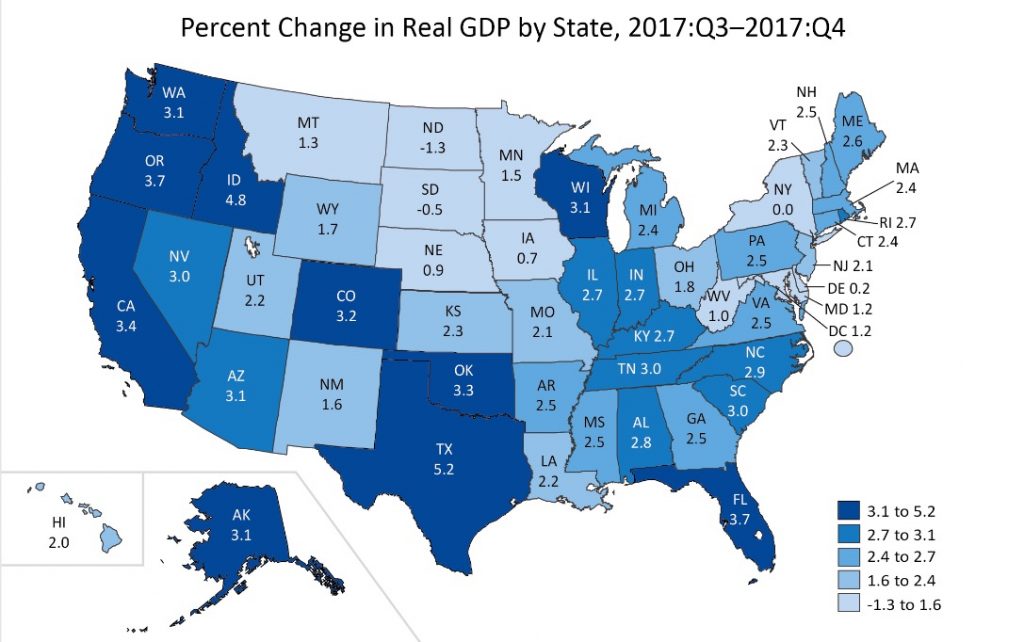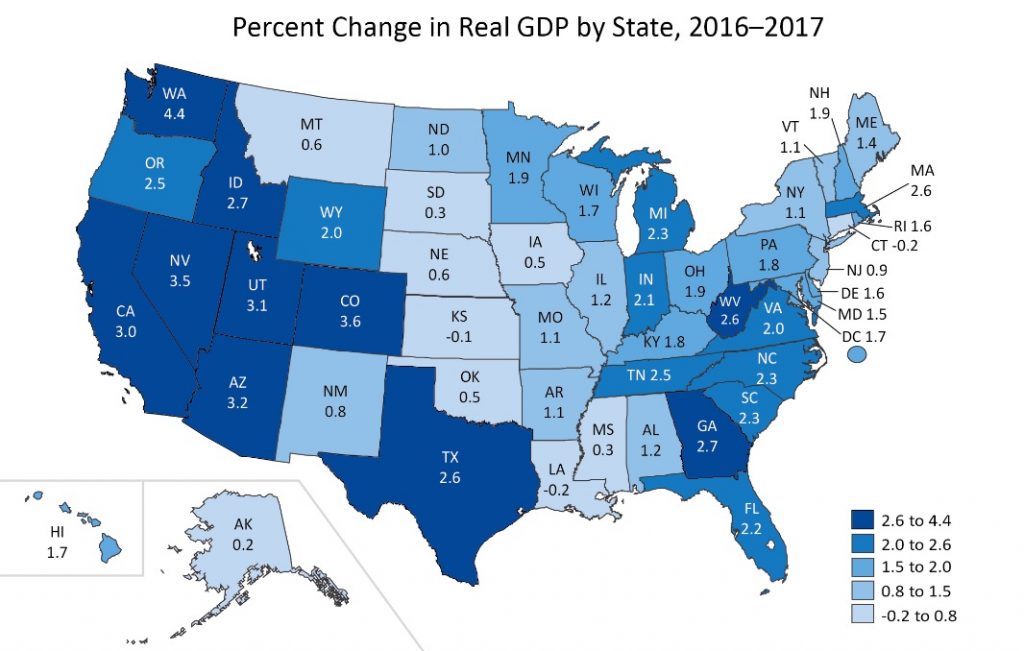Kristi Noem is right: South Dakota’s economy is stagnating. According to the Bureau of Economic Analysis, South Dakota and North Dakota were the only states whose real gross domestic product shrank in Quarter 4 of 2017:

We eked out 0.3% growth for the year, the slowest GDP growth among our adjoining states:

We tied Mississippi for most meager growth; Kansas, Louisiana, and Connecticut suffered minor shrinkage.
Mike Maciag of Governing plugs in population numbers and finds South Dakota distinguishes itself with the worst decrease in real GDP per capita, down 0.6%. Only four other states—Montana, Kansas, Connecticut, and Louisiana—saw their economies produce less wealth per person in 2017 than in 2016.
| State | 2016-17 Real GDP | 2016-17 Real GDP Per Capita |
| West Virginia | 2.6% | 3.3% |
| Wyoming | 2.0% | 3.0% |
| Washington | 4.4% | 2.7% |
| California | 3.0% | 2.3% |
| Colorado | 3.6% | 2.2% |
| Massachusetts | 2.6% | 2.0% |
| Michigan | 2.3% | 2.0% |
| Arizona | 3.2% | 1.7% |
| Pennsylvania | 1.8% | 1.7% |
| Hawaii | 1.7% | 1.7% |
| Indiana | 2.1% | 1.6% |
| Ohio | 1.9% | 1.6% |
| Nevada | 3.5% | 1.5% |
| Georgia | 2.7% | 1.5% |
| Illinois | 1.2% | 1.5% |
| Tennessee | 2.5% | 1.4% |
| Kentucky | 1.8% | 1.4% |
| Rhode Island | 1.6% | 1.4% |
| Virginia | 2.0% | 1.3% |
| New Hampshire | 1.9% | 1.3% |
| Wisconsin | 1.7% | 1.3% |
| Utah | 3.1% | 1.2% |
| Texas | 2.6% | 1.2% |
| North Carolina | 2.3% | 1.2% |
| Oregon | 2.5% | 1.1% |
| Maryland | 1.5% | 1.1% |
| New York | 1.1% | 1.1% |
| Vermont | 1.1% | 1.1% |
| South Carolina | 2.3% | 1.0% |
| Maine | 1.4% | 1.0% |
| North Dakota | 1.0% | 1.0% |
| Minnesota | 1.9% | 0.9% |
| Alabama | 1.2% | 0.9% |
| Missouri | 1.1% | 0.7% |
| New Mexico | 0.8% | 0.7% |
| Florida | 2.2% | 0.6% |
| Delaware | 1.6% | 0.6% |
| Arkansas | 1.1% | 0.6% |
| New Jersey | 0.9% | 0.6% |
| Idaho | 2.7% | 0.5% |
| Alaska | 0.2% | 0.5% |
| District of Columbia | 1.7% | 0.3% |
| Oklahoma | 0.5% | 0.3% |
| Mississippi | 0.3% | 0.3% |
| Iowa | 0.5% | 0.1% |
| Nebraska | 0.6% | 0.0% |
| South Dakota | 0.3% | -0.6% |
| Montana | 0.6% | -0.5% |
| Kansas | -0.1% | -0.2% |
| Connecticut | -0.2% | -0.2% |
| Louisiana | -0.2% | -0.2% |
As usual, Minnesota outperformed South Dakota on all three of these measures. in 2017, Minnesotans got richer per person while South Dakotans got poorer.
South Dakota can expect “stagnation” for a good while.
Even with the unemployment rate at 3.9% the tax cut (jobs program), wages showed no growth.
It is simple economics, if wages don’t grow neither will the state or nation’s economy.
Does Candidate Cory have an explanation for why this is happening? A solution for this problem? It’s apparent that your opponent likes low wages and deals in outdoor recreation dollars, which only account for 2% of GDP, so he’s oblivious to the problem.
New York is at Zero.
SD’s biggest industry is still agriculture (arguably). With commodity currently down for the foreseeable future, GDP growth looks bleak in our State.
Jason/KM … thanks for not posting a link. Are you confusing zero with your IQ? lol
In 2017, New York real GDP grew 1.1 percent; the 2016-2017 national change was 2.1 percent. The 2007-2017 compound annual growth rate for New York real GDP was 1.2 percent; the compound annual growth rate for the nation was 1.2 percent. Mar 22, 2018
New York
https://www.bea.gov/regional/bearfacts/pdf.cfm?fips=36000&areatype=STATE…
I had to stop and make sure I was on the right website after reading the first four words.
Porter,
Look at the first graphic Cory posted and tell us what number New York has?
I will give you a hint because you are stupid.
ZERO
Cory,
Who are you running against and will you have a debate against them?
Google is a wonderful tool to find information you are looking for.
I recognize that South Dakota’s economic stagnation in 2017 is due in part to continuing low ag prices, which are due in part to factors beyond any farmer’s or politician’s control.
To Mr. Sol’s point, I recognize that agriculture is one of our biggest industries. However, BEA stats indicate that finance and insurance is the biggest by GDP, followed by government, manufacturing, real estate and rental and leasing, and health care and social assistance. Ag ties with retail trade.
The logical response to volatility in one sector would be to diversify our economy so that a downturn in one sector doesn’t hurt us as much. If the current diversification isn’t enough, then sure, we should diversify further, if that’s possible with our natural and human resources. The more workers we have, the more diverse jobs in diverse sectors we can support.
G. Mark Mickelson’s narrow-minded belief that CAFOs are the only viable economic development plan for rural South Dakota is part of the problem. We can do more than raise hogs and spread manure. More stinky hog barns don’t make people want to buy big houses and move their families here. We can improve our quality of life with better schools, better roads, better parks, and better public services.
We can attract more workers if we stop acting like jerks: specifically, stop advocating racial profiling (Al Novstrup), stop scapegoating people by religion and race (Neal Tapio), stop discriminating against gay, lesbian, transgender, female, and insufficiently religious people (most GOP legislators), and stop telling the world that we think liberal arts majors are useless (Dennis Daugaard).
We can attract more workers with more skill and creative ideas by raising wages. The state can’t do that single-handedly for every worker in every industry, but we can start by setting the bar for teachers and state employees. Offer truly competitive wages, give those public employees (a big chunk of every community) more spending power, and they’ll drive more economic activity in their communities. Plus they’ll keep applying their talents to making our communities better.
There is no one vote I cast in Pierre or one bill I write that boosts South Dakota’s GDP five percentage points. But there are many important things we can do that will add up to better quality of life and more people willing to either stay here or migrate here and cast their fortunes with us in South Dakota.
Jason, I’m running against Al Novstrup. I welcome opportunities to debate him publicly, in person, about clear topics of substance throughout the campaign. Unfortunately our local media don’t host many debates, and the Chamber and League of Women Voters tried a new format tonight with city council and school board candidates: a series of canned opening statements, then break the audience into small groups for one-on-one chats with candidates. I find that new format less instructive for large audiences and for reporting and rebroadcast.
Cory wrote:
We can attract more workers with more skill and creative ideas by raising wages. But we can start by setting the bar for teachers and state employees
Private sector wages aren’t determined by Government.
Please explain how paying teachers and State workers more will raise wages in SD?
Also, Please explain what the impact on the State pension plan would be on paying teachers and State workers more?
As usual, Cory sums it up best. Cory if you were in any other state you would’ve been elected along time ago.
Agriculture is happy to tighten their belts during Trump administration, and they cried and whined like babies about their imaginary definition of ‘liberalism’ the whole time they raked in great profits under Obama.
In combination with China recently refusing to buy any more U.S. soy, I hope conservative culture punches U.S. Agriculture right in the gut – makes it double over – and vomit – as that’s what these people deserve right about now.
Democrats trying to represent farmers and ranchers (and West Virginia coal miners), in this modern day, is like as if Martian Luther King Jr. stood for improving the quality of life for slaves in the Old South – while standing FOR slavery.
At what point should a person stop trying to help people – who take help, and then immediately scorn you for all that you stand for? I say, “perhaps, right now.”
Does Jason purposely try to be obtuse? He either believes teachers and state employees are part of the “private sector” or that paying them a competitive wage will have no impact on the economies of the communities in which they live, and ultimately the state.
Dave,
Answer my questions to Cory. Your post is not talking about what I said.
South Dakota is sour grapes on developing its private sector – because it doesn’t know how, and it’s people would rather keep most-all of the state’s eggs in the socialized Ag. basket, letting the Federal government fix prices for them, and care for them like a patient nanny parenting a bratty child who REALLY needs to grow up a little.
Farmers and ranchers, largely, couldn’t understand business to save their souls. They are the people who mostly think college is bad because it’s where your kids get ‘brain warshed’ and indoctrinated into liberalism. They just don’t value brains. In fact, they have distain for brains, and that’s one primary reason they don’t like the speaking (proper English) of city people. When they can’t follow a more complex thought – they claim city folks have an attitude problem as a cop out.
Economic diversity, as a concept, is waaay over Conservakota’s head, and it sounds like an invite for more colored and Muslim people to move here. Rural folks are pathetically unaware of the world around, and nowadays, so anti-American that it’s truly, and deeply, offensive.